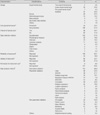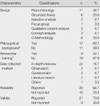Abstract
Purpose
This study aimed was done to analyze recent trends in nursing research published in the Journal of Korean Academy of Nursing by focusing on the content of nursing interventions and their level of evidence.
Methods
A total of 209 studies published between 2007 and 2008 were reviewed using analysis criteria developed by the researchers.
Results
The number of quantitative studies was greater than that of qualitative studies. There was a slight increase in the number of qualitative studies and studies including elderly populations, which reflects the recent population trend in Korea. More randomized controlled trials with a low risk of bias were needed to support more evidence-based nursing practice. Concerning the low rate of ethical consideration, stricter application of research ethics needs to be encouraged.
References
1. Choi KS, Song MS, Hwang AR, Kim KH, Chung MS, Shin SR, et al. The trend of nursing research in the Journal of the Korean Academy of Nursing. Journal of Korean Academy of Nursing. 2000. 30:1207–1218.
2. Davies D, Dodd J. Qualitative research and the question of rigor. Qualitative Health Research. 2002. 12:279–289.
3. Dougherty MC, Lin SY, McKenna HP, Seers K. International content of high ranking nursing journals in the year 2000. Journal of Nursing Scholarship. 2004. 2:173–179.
4. Fawcett J. The state of nursing science: Hallmarks of the 20th and 21st centuries. Nursing Science Quarterly. 1999. 12:311–318.
5. Jang SO. Analysis of research papers published in the Journal of Korean Academy of Nursing by the classification of knowingin nursing. Journal of Korean Academy of Nursing. 2005. 35:206–212.
6. Jeong GH, Ahn YM, Cho DS. Coincidence analysis of key words of the Journal of Korean Academy of Nursingwith MeSH. Journal of Korean Academy of Nursing. 2005. 35:1420–1425.
7. Kang HC. Analysis of statistical method applied in the Journal of Korean Academy of Nursing. Journal of Korean Academy of Nursing. 2002. 35:929–935.
8. Mantzoukas S. A review of evidence-based practice, nursing research and reflection: Levelling the hierarchy. Journal of Clinical Nursing. 2008. 17:214–223.
9. Mantzoukas S. The research evidence published in high impact nursing journals between 2000 and 2006: A quantitative content analysis. International Journal of Nursing Studies. 2009. 46:479–489.
10. McEwen M. McEwen W, Melanie EM, editors. Philosophy, science, and nursing. Theoretical basis for nursing. 2007. Philadelphia, PA: Lippincott-Williams and Wilkins;12–13.
11. Morse KM. Reconceptualizing qualitative evidence. Qualitative Health Research. 2006. 16:415–422.
12. Park MH. Understanding and application of Evidence Based Practice. 2006. Seoul: Kunga Publishing Company.
13. Park YW, Lee YW, Kim OS, Cho MO. The trends of nursing research in the Journal of Korean Academy of Adult Nursing. Journal of Korean Academy of Adult Nursing. 2008. 20:176–186.
14. Peterson SJ. Peterson SJ, Bredow TS, editors. Introduction to the nature of nursing knowledge. Middle range theories. 2009. Philadelphia, PA: Lippincott-Williams and Wilkins;35–36.
15. Rahm-Hallberg I. Challenges for future nursing research: Providing evidence for health-care practice. International Journal of Nursing Studies. 2006. 43:923–927.
16. Rycroft-Malone J. Theory and knowledge translation: Setting some coordinates. Nursing Research. 2007. 56:Suppl. 4. 78–85.
17. Seers K. Evaluating complex interventions. Worldviews on Evidence-Based Nursing. 2007. 4(2):67–68.
18. Suh YO, Park JS, Yang JH, Kim HW, Suk MH, Shin HS, et al. Analysis of research papers published in the Journal of Korean Academy of Nursing. Journal of Korean Academy of Nursing. 2007. 37:1013–1019.
19. Wallin L. Knowledge translation and implementation research in nursing. International Journal of Nursing Studies. 2009. 46:576–587.
20. Walker W. The strengths and weaknesses of research designs involving quantitative measures. Journal of Research in Nursing. 2005. 10:571–582.
21. Webb C. An analysis of recent publications in JCN: Sources, methods and topics. Journal of Clinical Nursing. 2003. 12:931–934.




 PDF
PDF ePub
ePub Citation
Citation Print
Print







 XML Download
XML Download